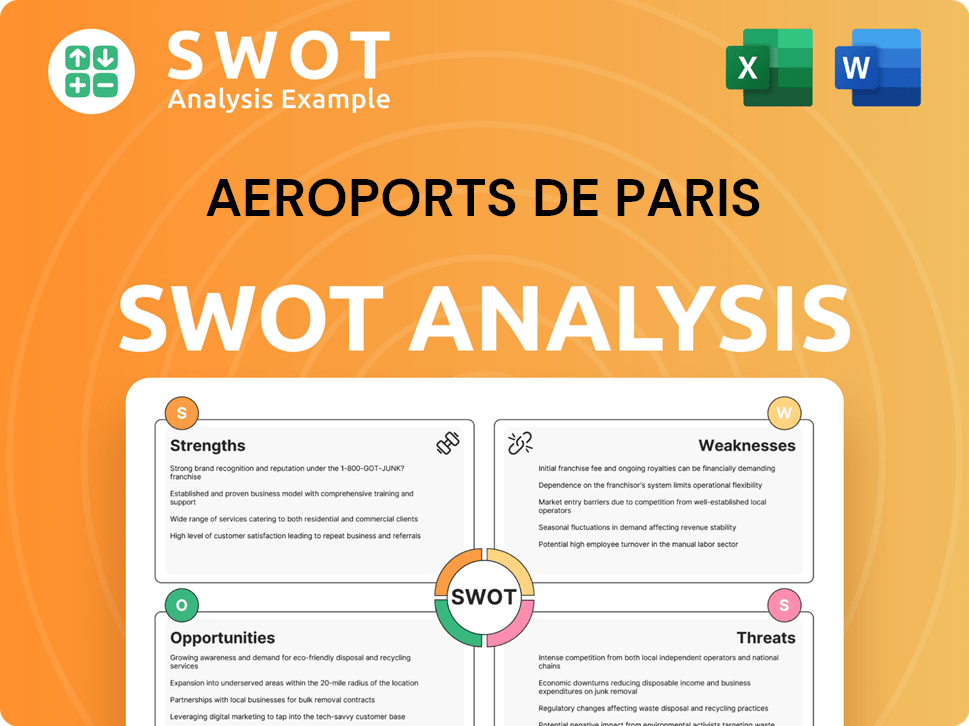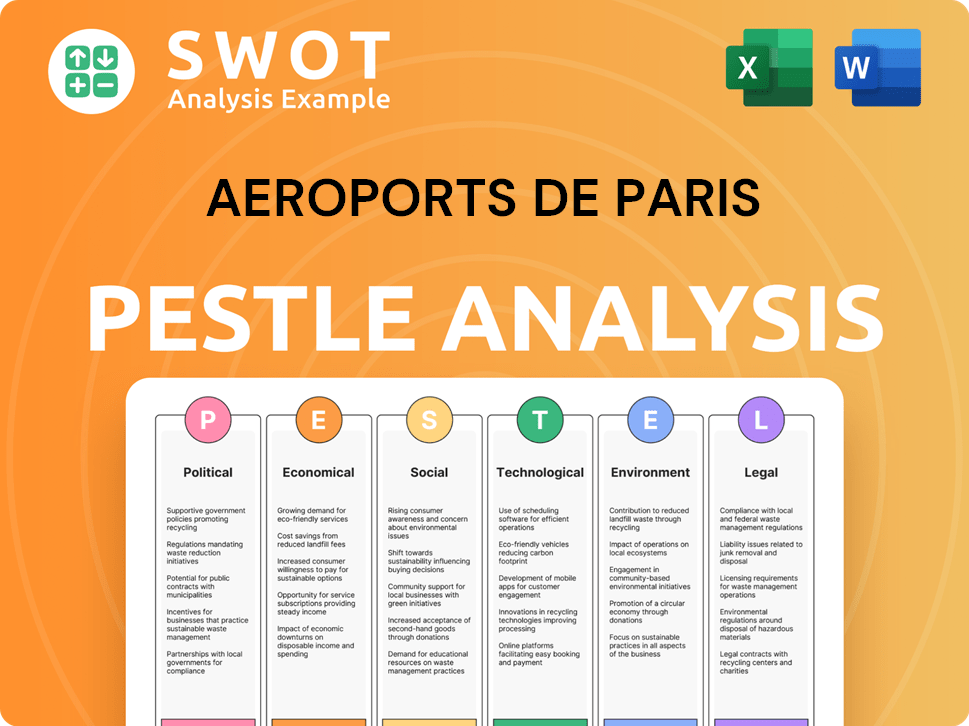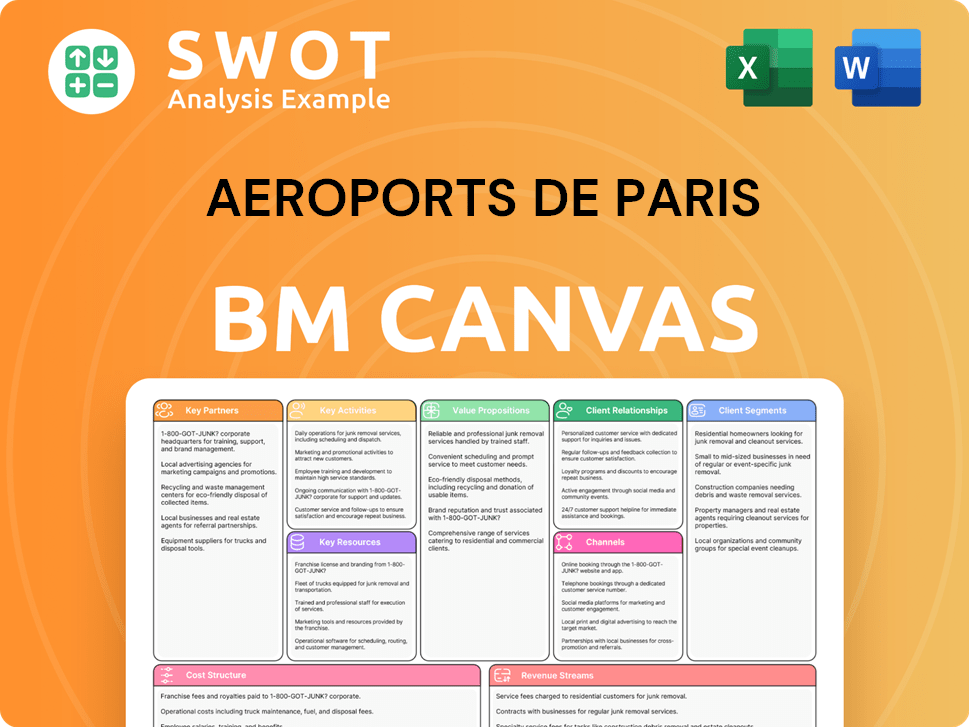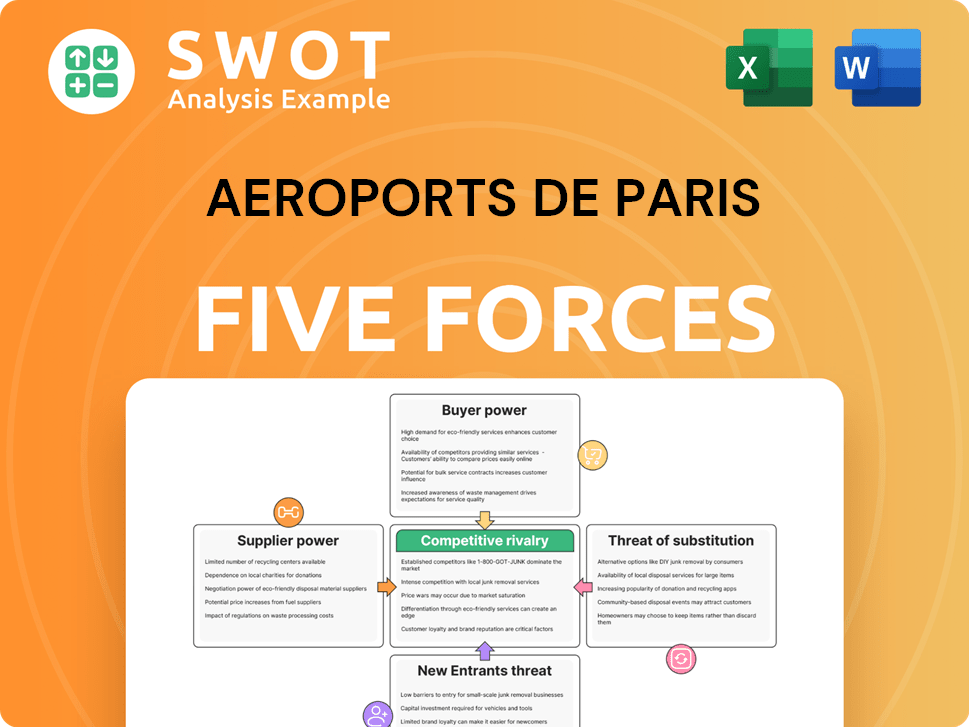Aeroports de Paris Bundle
Who Flies Through Aeroports de Paris?
The aviation industry thrives on understanding its diverse customer base, and for Aéroports de Paris (ADP), this understanding is paramount. As the operator of Paris's major airports, ADP's ability to thrive hinges on a deep dive into its customer demographics and target markets. The post-pandemic era has brought significant shifts in passenger expectations, making this analysis more critical than ever.

ADP's evolution from a post-war infrastructure provider to a multifaceted business highlights the importance of continuous adaptation. Analyzing the Aeroports de Paris SWOT Analysis provides insights into how ADP can refine its strategies. Understanding the ADP customer profile, including factors like passenger origin countries and spending habits, is essential for maintaining a competitive edge and driving growth in a dynamic global market. This includes detailed ADP passenger analysis and understanding the airport customer segmentation.
Who Are Aeroports de Paris’s Main Customers?
Understanding the primary customer segments is crucial for Aeroports de Paris (ADP) to tailor its services and maximize revenue. The company serves a diverse range of customers, both in the business-to-consumer (B2C) and business-to-business (B2B) sectors. Analyzing the customer demographics and target market allows ADP to optimize its offerings and enhance the overall airport experience.
On the B2C side, ADP's customer profile includes various passenger segments. These segments are broadly categorized into business travelers, leisure travelers, and connecting passengers. Each group has distinct needs and preferences, influencing the services and amenities provided at the airports. In 2023, the passenger traffic statistics for Paris Charles de Gaulle Airport reached 67.4 million, while Paris Orly Airport served 34.3 million passengers, highlighting the significance of these segments.
ADP's B2B customers are also essential to its operations. These include airlines, cargo operators, ground handling companies, and commercial tenants. Airlines rely on ADP for efficient operations, while cargo operators use the infrastructure for logistics. Commercial tenants, such as retailers and food and beverage outlets, contribute significantly to ADP's revenue, generating €1,332 million in 2023 from retail and real estate activities.
ADP's market segmentation strategy focuses on both passenger and business customers. Passenger segments include business travelers, leisure travelers, and connecting passengers, each with unique needs. Business customers comprise airlines, cargo operators, and commercial tenants, all contributing to ADP's revenue streams and operational efficiency.
Business travelers prioritize efficiency, leisure travelers value experience, and connecting passengers need seamless transfers. Airlines depend on ADP for operational support, cargo operators for logistics, and commercial tenants for retail opportunities. Understanding these groups helps ADP tailor its services.
ADP's revenue streams are diverse, with a significant portion coming from retail and real estate. Airlines contribute through landing fees and operational charges. Passenger traffic, especially leisure travelers, drives retail sales. These revenue streams are crucial for the financial health of ADP.
ADP's strategic focus has evolved to enhance the passenger experience and expand retail offerings. The growth in international tourism, particularly from emerging markets, influences this focus. ADP continuously adapts to meet the changing needs of its diverse customer base.
ADP conducts ADP passenger analysis to understand customer preferences and behaviors. This includes analyzing passenger origin countries and assessing average income levels. Customer satisfaction surveys and passenger spending habits are also key areas of focus.
- Business travelers often have higher incomes and prioritize efficiency.
- Leisure travelers are diverse, valuing retail and dining options.
- Connecting passengers need efficient transfers and amenities.
- ADP uses data to tailor services and improve customer loyalty.
Aeroports de Paris SWOT Analysis
- Complete SWOT Breakdown
- Fully Customizable
- Editable in Excel & Word
- Professional Formatting
- Investor-Ready Format

What Do Aeroports de Paris’s Customers Want?
Understanding the needs and preferences of its diverse customer base is crucial for Aeroports de Paris (ADP). The ADP customer profile encompasses a wide range of travelers, each with unique expectations and priorities. This includes both business and leisure travelers, each influencing the airport's services and offerings.
Paris airports passengers have varied needs, from efficiency and convenience to comfort and entertainment. ADP aims to cater to these diverse demands through strategic investments in infrastructure, technology, and customer service. This approach ensures a positive experience for all passengers.
ADP passenger analysis reveals distinct segments, each with specific behaviors and preferences. Business travelers prioritize speed and efficiency, while leisure travelers focus on comfort and amenities. ADP tailors its services to meet these specific needs, enhancing customer satisfaction and loyalty.
Business travelers value efficiency and time-saving solutions. They frequently use premium lounges and express security services. Their needs include quick security checks, seamless boarding, and readily available connectivity.
Leisure travelers prioritize comfort, entertainment, and a pleasant overall experience. They often spend more time in retail areas and utilize family-friendly facilities. Their preferences include diverse dining options, retail choices, and comfortable waiting areas.
Product/service usage varies significantly between business and leisure travelers. Business travelers might frequently use premium lounges and express security, while leisure travelers might spend more time in retail areas. This influences ADP's service offerings.
Loyalty for both segments includes consistent service quality, efficient operations, and a positive emotional connection. ADP focuses on these factors to build strong customer relationships and encourage repeat business. This enhances overall customer experience.
Common pain points ADP addresses include long wait times, lack of clear information, and limited F&B options during peak hours. Addressing these issues is crucial for improving passenger satisfaction. ADP uses feedback to improve service.
Feedback mechanisms, such as passenger surveys and digital platforms, directly influence product development and service enhancements. ADP uses this feedback to tailor its offerings and improve the passenger experience. This helps refine services.
ADP's retail strategy includes luxury boutiques for high-spending international travelers and duty-free shops for a broader base. The company's 2022-2025 roadmap aims to make Paris airports 'more welcoming, more efficient, and more sustainable.' In 2023, passenger traffic at Paris airports reached 99.7 million, a 17.3% increase compared to 2022. ADP's commitment to enhancing the passenger experience is evident in its investments in self-service kiosks and improved baggage handling systems. These initiatives directly address passenger pain points regarding efficiency. This data underscores ADP's focus on improving passenger experience.
- Customer demographics Aeroports de Paris include a mix of business and leisure travelers.
- Aeroports de Paris target market focuses on diverse passenger segments.
- ADP passenger analysis reveals distinct needs and preferences.
- Paris airports passengers benefit from ADP's customer-centric approach.
- ADP customer profile is shaped by factors like age, income, and travel purpose.
Aeroports de Paris PESTLE Analysis
- Covers All 6 PESTLE Categories
- No Research Needed – Save Hours of Work
- Built by Experts, Trusted by Consultants
- Instant Download, Ready to Use
- 100% Editable, Fully Customizable

Where does Aeroports de Paris operate?
Aéroports de Paris (ADP), primarily focuses on the greater Paris metropolitan area as its core geographical market, operating three key airports: Charles de Gaulle (CDG), Orly (ORY), and Le Bourget (LBG). These airports serve as vital gateways for both international and domestic travel to and from France. CDG is a major international hub, acting as a crucial connection point for long-haul flights across various continents.
Beyond its domestic operations, ADP has expanded its reach internationally through 'ADP International', which involves investments and operations in airports worldwide. This global presence helps ADP diversify its revenue streams and apply its airport management expertise. As of 2023, ADP's international network included participations in 20 airports globally, handling a total of 152.9 million passengers across its consolidated and equity-accounted airports. This includes operations in regions like Turkey, Jordan, and Madagascar.
The differences in customer demographics and preferences are evident across these regions. For instance, an airport in a developing market might prioritize basic infrastructure and operational efficiency, while an airport in a mature market might focus on premium services and diverse retail offerings. ADP adapts its offerings by adjusting its retail mix, food and beverage options, and cultural amenities to meet passenger expectations in each region. Recent expansions have focused on strategic partnerships and concessions in emerging markets, aiming to capitalize on growing air travel demand. The geographic distribution of sales and growth is increasingly diversified, with international operations contributing a growing share to ADP's overall performance. To learn more about how ADP approaches its expansion, see the Growth Strategy of Aeroports de Paris.
The core geographical market for ADP is the greater Paris metropolitan area. This includes the operation of CDG, ORY, and LBG airports, which are crucial for both international and domestic travel.
ADP has a significant international presence through 'ADP International,' with investments and operations in airports worldwide. This diversification helps in revenue generation and leverages its airport management expertise.
In 2023, ADP had participations in 20 airports globally. These airports handled a total of 152.9 million passengers across its consolidated and equity-accounted airports. This includes operations in Turkey, Jordan, and Madagascar.
ADP tailors its offerings to suit the specific tastes and expectations of passengers in each region. This includes adjusting retail mixes, food and beverage options, and cultural amenities.
Aeroports de Paris Business Model Canvas
- Complete 9-Block Business Model Canvas
- Effortlessly Communicate Your Business Strategy
- Investor-Ready BMC Format
- 100% Editable and Customizable
- Clear and Structured Layout

How Does Aeroports de Paris Win & Keep Customers?
The customer acquisition and retention strategies of Aeroports de Paris (ADP) are designed to cater to both passengers (B2C) and business partners, primarily airlines and commercial tenants (B2B). For passengers, the focus is on ensuring Paris airports remain a preferred destination through superior experiences. For B2B clients, the emphasis is on creating strong, long-term partnerships through competitive advantages and tailored support.
ADP utilizes a multi-faceted approach to attract and keep customers. This includes working with airlines to secure new routes and increase flight frequencies, optimizing airport operations, and enhancing the overall passenger experience. Digital channels, such as websites and mobile apps, are also key, providing real-time information and services to improve the passenger journey. The company has shifted toward a more customer-centric approach, recognizing the importance of a superior passenger experience for both airline satisfaction and non-aeronautical revenue.
Retention strategies for passengers focus on enhancing the airport experience. This includes operational efficiency, diverse retail and dining options, and amenities like lounges. For B2B clients like airlines, retention is driven by competitive pricing, operational efficiency, and strong relationship management. ADP's long-term concession agreements with commercial tenants ensure stable revenue streams and foster strong partnerships. Customer data and CRM systems are becoming increasingly critical for both B2C and B2B segments, enabling ADP to personalize communications and target marketing campaigns more effectively.
ADP's primary method for acquiring passengers involves working with airlines to establish new routes and increase flight frequencies. This strategy is crucial because airlines' decisions determine the number of passengers using the airports. Improving the overall airport experience is also a key strategy, making Paris airports a preferred choice for travelers. Digital platforms like websites and mobile apps play a vital role in enhancing the passenger experience, offering real-time information and services.
To retain passengers, ADP focuses on improving the airport experience. This includes streamlining operations, such as baggage handling and security, to reduce wait times. Expanding and diversifying retail and dining options, along with providing comfortable amenities like lounges, also contribute to a positive experience. These improvements aim to foster repeat visits and positive word-of-mouth, which are essential for customer retention.
For B2B customers, such as airlines, ADP focuses on competitive pricing, efficient operations, and strong relationship management to foster retention. This approach includes providing tailored solutions to meet airlines' operational needs and maintaining high-quality infrastructure. Long-term concession agreements with commercial tenants also contribute to stable revenue streams and strong partnerships.
Digital channels are increasingly important, with ADP's websites and mobile apps providing real-time flight information, airport navigation, and access to services. Loyalty programs, integrated through partnerships with retailers and service providers, offer incentives and personalized experiences. The "My Paris Aéroport" loyalty program is an example, providing benefits to frequent users, which enhances customer retention.
Customer data and CRM systems are becoming increasingly critical for both B2C and B2B segments, enabling ADP to personalize communications and target marketing campaigns. This data-driven approach allows for more effective customer engagement and the ability to proactively address customer needs. By leveraging customer data, ADP can better understand passenger preferences and tailor services accordingly. For instance, in 2024, ADP invested significantly in upgrading its CRM systems to enhance its ability to analyze customer behavior and improve service delivery.
- Data Analysis: ADP uses data analytics to understand passenger behavior and preferences.
- Personalization: CRM systems enable personalized communication and targeted marketing.
- Proactive Service: Data helps in anticipating and addressing customer needs.
- Continuous Improvement: Customer feedback is used to improve services and infrastructure.
Aeroports de Paris Porter's Five Forces Analysis
- Covers All 5 Competitive Forces in Detail
- Structured for Consultants, Students, and Founders
- 100% Editable in Microsoft Word & Excel
- Instant Digital Download – Use Immediately
- Compatible with Mac & PC – Fully Unlocked

Related Blogs
- What are Mission Vision & Core Values of Aeroports de Paris Company?
- What is Competitive Landscape of Aeroports de Paris Company?
- What is Growth Strategy and Future Prospects of Aeroports de Paris Company?
- How Does Aeroports de Paris Company Work?
- What is Sales and Marketing Strategy of Aeroports de Paris Company?
- What is Brief History of Aeroports de Paris Company?
- Who Owns Aeroports de Paris Company?
Disclaimer
All information, articles, and product details provided on this website are for general informational and educational purposes only. We do not claim any ownership over, nor do we intend to infringe upon, any trademarks, copyrights, logos, brand names, or other intellectual property mentioned or depicted on this site. Such intellectual property remains the property of its respective owners, and any references here are made solely for identification or informational purposes, without implying any affiliation, endorsement, or partnership.
We make no representations or warranties, express or implied, regarding the accuracy, completeness, or suitability of any content or products presented. Nothing on this website should be construed as legal, tax, investment, financial, medical, or other professional advice. In addition, no part of this site—including articles or product references—constitutes a solicitation, recommendation, endorsement, advertisement, or offer to buy or sell any securities, franchises, or other financial instruments, particularly in jurisdictions where such activity would be unlawful.
All content is of a general nature and may not address the specific circumstances of any individual or entity. It is not a substitute for professional advice or services. Any actions you take based on the information provided here are strictly at your own risk. You accept full responsibility for any decisions or outcomes arising from your use of this website and agree to release us from any liability in connection with your use of, or reliance upon, the content or products found herein.